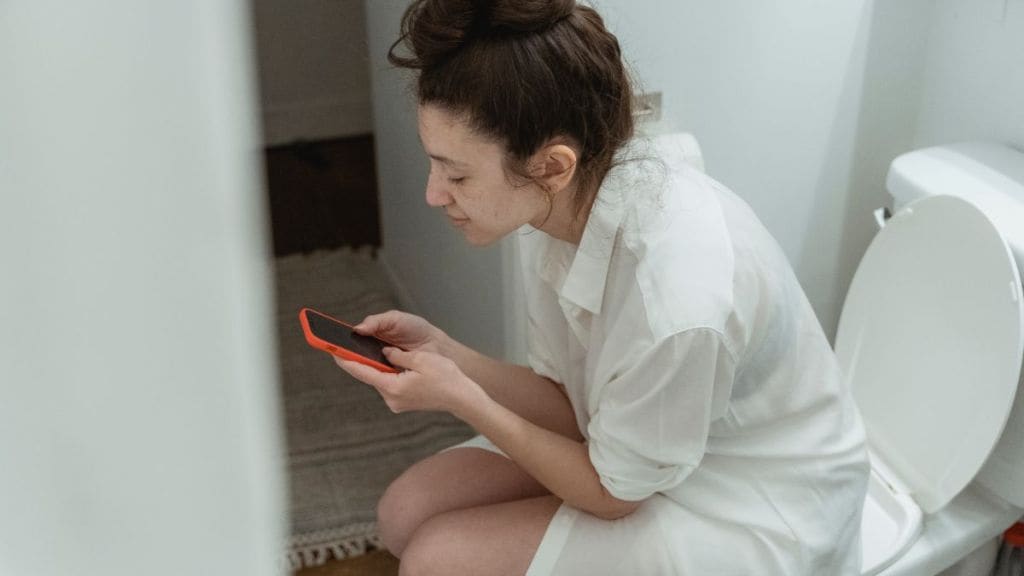Spending hours with your smartphone in toilet? Research says the seemingly harmless habit could lead to a painful condition that can stretch for weeks, months or years.
Losing track of time while scrolling endlessly on the porcelain throne is becoming common among people, as many look at the habit as a way to relax and unwind. However, spending more than 5 minutes on the throne has health implications. A new study published in the journal PLOS One notes that doing so could be putting people at risk of hemorrhoids, a condition associated with pain, itching, and bleeding in the anus or lower rectum.
Doctors in the study found out that people who scroll on their smartphones while on the toilet have a 46% greater chance of developing hemorrhoids compared to those who leave their devices outside the bathroom.
Researchers clarify that the risk of hemorrhoids go up not because of straining, but due to duration of sitting.
How the study was carried out
A study of 125 patients undergoing screening colonoscopies found that those using smartphones in the group spent significantly more time on the toilet. It was found that around 37 percent of people who participated in the study and reported using smartphones on the toilet spent more than five minutes per bathroom visit compared with 7 percent who didn’t use the phones.
The study concluded that smartphone use was linked with a 46 per cent increased risk of hemorrhoids.
Dr. Trisha Pasricha, an instructor of medicine at Harvard Medical School and director of the Institute for Gut-Brain Research at Beth Israel Deaconess Medical Center led the study.
Chethan Ramprasad, a gastroenterologist and one of the study authors says hemorrhoids are often overlooked and are “not taken as seriously.”
“No one really wants to talk about something that’s in their anus rectum, but this is incredibly human,” Ramprasad said. The health condition accounts for nearly 4 million US outpatient and emergency visits annually and costs over $800 million each year in healthcare expenditures.
Why prolonged sitting on the toilet seat is problematic
Sitting in a chair for hours will not have the same implications as sitting on a toilet throne. This is because a chair provides pelvic support as opposed to a toilet seat that doesn’t have any pelvic support and ends up creasing increased pressure in the hemorrhoidal cushions without any support underneath.
National Library of Medicine notes that due to this persisting pressure over extended time, the hemorrhoidal cushions can become engorged leading to a painful, swollen condition affecting millions.
How smartphone is affecting toilet habits
The study also delved into the age group that was facing the brunt of excessive smartphone use. These users had an average age of 55.4 years compared to 62.1 years for non-users. They also exercised significantly less than those who didn’t use their phones in the bathroom.
As many as 93% smartphone users admitted using their devices on the toilet at least once or twice per week. Close to 55% said they used their phones most of the time during bathroom visits.
Common things people watch in toilet
The study discovered that 54% users enjoyed reading news in the toilet, while scrolling on social media was observed in 44% users. Gaming, watching videos, and other activities rounded were other common smartphone behaviors inside the washrooms.
Reading news was the most popular activity at 54%, followed by social media browsing at 44%. Gaming, watching videos, and other activities rounded out the list of common smartphone behaviors during bathroom breaks.
“Prolonged sitting outside of the toileting environment, i.e., at a desk at work or at home at leisure, this kind of sitting typically involves some support to the pelvic floor through a chair or couch,” the researchers said. “However, we propose that sitting on a standard toilet seat, without any support to the pelvic floor, disproportionately increases pressure in the hemorrhoidal cushions.”
What is passive engagement?
Researchers have an interesting observation about why people lose track of time while using smartphones and called it a “passive engagement”. People may not realise that they are using smartphones for longer than intended as the content available on smartphones doesn’t have an endpoint and there is no end to the social media feeds, articles and video content. On the other hand an activity like reading a newspaper has an endpoint, and is a healthier habit than scrolling.


